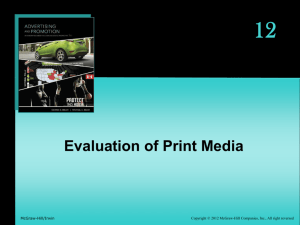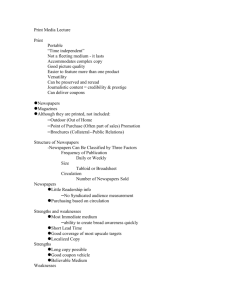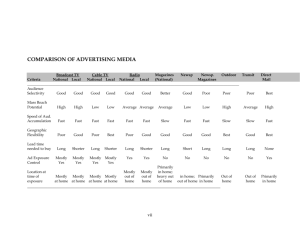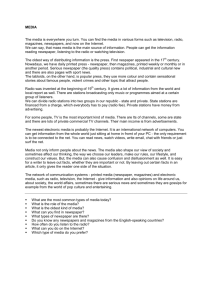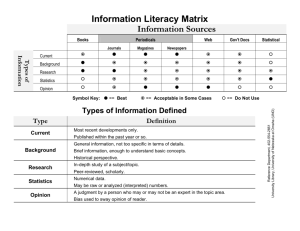i. introduction and the role of magazines and
advertisement
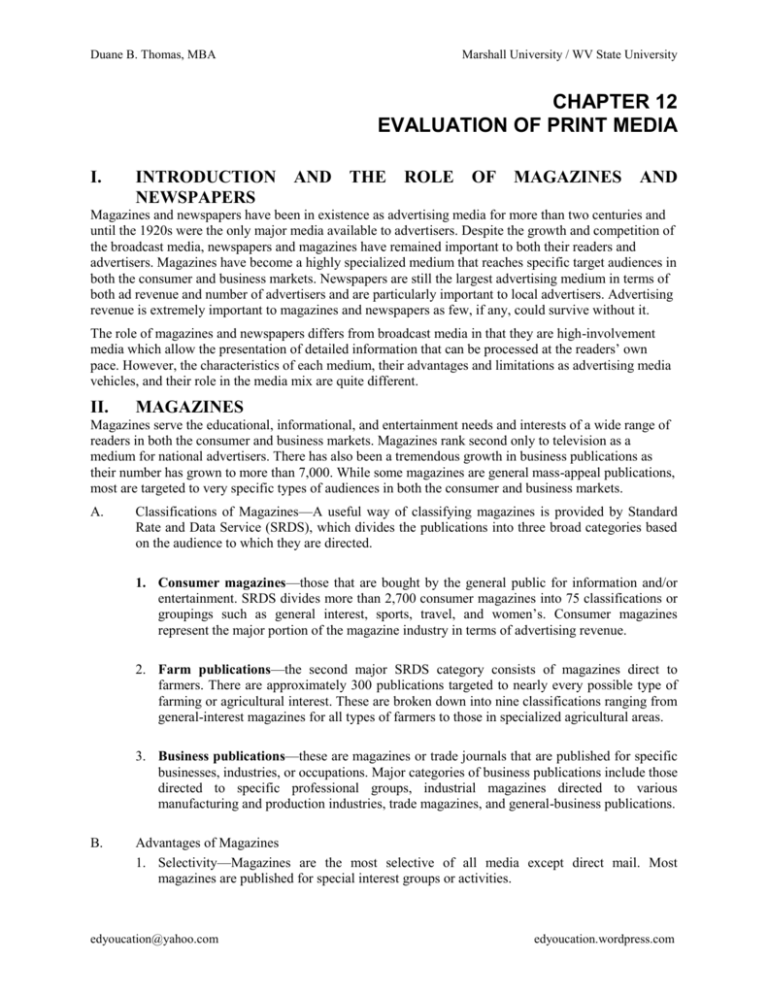
Duane B. Thomas, MBA Marshall University / WV State University CHAPTER 12 EVALUATION OF PRINT MEDIA I. INTRODUCTION AND THE ROLE OF MAGAZINES NEWSPAPERS AND Magazines and newspapers have been in existence as advertising media for more than two centuries and until the 1920s were the only major media available to advertisers. Despite the growth and competition of the broadcast media, newspapers and magazines have remained important to both their readers and advertisers. Magazines have become a highly specialized medium that reaches specific target audiences in both the consumer and business markets. Newspapers are still the largest advertising medium in terms of both ad revenue and number of advertisers and are particularly important to local advertisers. Advertising revenue is extremely important to magazines and newspapers as few, if any, could survive without it. The role of magazines and newspapers differs from broadcast media in that they are high-involvement media which allow the presentation of detailed information that can be processed at the readers’ own pace. However, the characteristics of each medium, their advantages and limitations as advertising media vehicles, and their role in the media mix are quite different. II. MAGAZINES Magazines serve the educational, informational, and entertainment needs and interests of a wide range of readers in both the consumer and business markets. Magazines rank second only to television as a medium for national advertisers. There has also been a tremendous growth in business publications as their number has grown to more than 7,000. While some magazines are general mass-appeal publications, most are targeted to very specific types of audiences in both the consumer and business markets. A. Classifications of Magazines—A useful way of classifying magazines is provided by Standard Rate and Data Service (SRDS), which divides the publications into three broad categories based on the audience to which they are directed. 1. Consumer magazines—those that are bought by the general public for information and/or entertainment. SRDS divides more than 2,700 consumer magazines into 75 classifications or groupings such as general interest, sports, travel, and women’s. Consumer magazines represent the major portion of the magazine industry in terms of advertising revenue. 2. Farm publications—the second major SRDS category consists of magazines direct to farmers. There are approximately 300 publications targeted to nearly every possible type of farming or agricultural interest. These are broken down into nine classifications ranging from general-interest magazines for all types of farmers to those in specialized agricultural areas. 3. Business publications—these are magazines or trade journals that are published for specific businesses, industries, or occupations. Major categories of business publications include those directed to specific professional groups, industrial magazines directed to various manufacturing and production industries, trade magazines, and general-business publications. B. Advantages of Magazines 1. Selectivity—Magazines are the most selective of all media except direct mail. Most magazines are published for special interest groups or activities. edyoucation@yahoo.com edyoucation.wordpress.com Duane B. Thomas, MBA Marshall University / WV State University 2. Reproduction quality—magazines are generally printed on high-quality paper stock and sue printing processes that provide excellent reproduction in black and white or color. 3. Creative flexibility—Some magazines offer a variety of special options that can enhance the creative appeal of the ad and increase attention and readership. Examples include gatefolds, bleed pages, inserts, pop-ups, and creative space buys such as half or quarter page ads. 4. Permanence—Magazines are often kept for reference and/or read over several days. One benefit of the longer life of magazines is that reading occurs at a less hurried pace and there is more opportunity to examine ads in considerable detail. 5. Prestige—Companies whose products rely heavily on perceived quality, reputation, and/or image often buy space in prestigious publications with high-quality editorial content whose consumers have a high level of interest in the advertising pages. 6. Consumer receptivity and involvement—Magazines are generally purchased because the information they contain interests the reader, and ads provide additional information that may be of value in making a purchase decision. As shown in Figure 12-2, consumers consider magazines to be the primary source of information for a variety of products and services. 7. Services—Some magazines have merchandising staff that call on trade intermediaries like retailers to let them know a product is being advertised. Magazines also offer such as split runs whereby two or more versions of an ad are printed in alternate copies of a particular issue of a magazine; selective binding which enables magazine to target specific groups with different versions of a magazine; and ink-jet imaging which makes it possible to personalize an advertising message. C. Disadvantages of Magazines 1. Costs— The absolute cost of advertising in large mass-circulation magazines like Reader’s Digest , Time or People can be very expensive, particularly for popular positions such as back covers. 2. Limited reach and frequency—The percentage of adults reading any individual publication tends to be much smaller, so magazines have a thin penetration of households. Thus, companies who want to reach mass markets have to buy space in a number of magazines. 3. Long lead time—Most major publications have a 30- to a 90-day lead time, which means space must be purchased and the ad must be prepared well in advance of the actual publication date. 4. Clutter and competition for readers’ attention—Clutter is a problem for magazines as the average consumer magazine contains ads on 45 percent of its pages while some publications contain as much as 70 percent. The clutter problem for magazines is something of a paradox: the more successful a magazine becomes, the more advertising pages it attracts, which leads to greater clutter. edyoucation@yahoo.com edyoucation.wordpress.com Duane B. Thomas, MBA D. Marshall University / WV State University Magazine Circulation and Readership—Two of the most important considerations in deciding whether to utilize a magazine in the media plan are the size and characteristics of the audience reached by the publication. Important considerations include the circulation of the publication as well as its total readership. 1. Circulation—circulation figures represent the number of individuals who receive a publication, either through subscription or store purchase. The number of copies distributed to original subscribers or purchasers is known as primary circulation and is used as the basis for the magazine’s rate structure. Many publications base their rates on guaranteed circulation and provide rebates if the number of delivered magazines fall below the guarantee. a. Circulation verification—these services are provided by several companies to ensure circulation figures for magazines are accurate. Consumer magazines and farm publications are audited by the Audit Bureau of Circulations (ABC) while certain business publications are audited by the Business Publications Audit (BPA) of Circulation. 2. Readership and total audience—in addition to primary circulation figures, advertisers may be interested in the number of people that a publication reaches as a result of secondary or passalong readership. Total audience or readership of a magazine can be determined by taking the readers per copy and multiplying this figure by the circulation of an average issue. E. Audience Research for Magazines—Media planners are interested in the match between a magazine’s readers and the advertiser’s target audience. Information on readers' demographic, lifestyle and product usage characteristics are available from studies conducted by the magazines themselves as well as from syndicated research studies. The primary sources of information concerning magazine audiences are: Standard Rate and Data Service (SRDS) Simmons Market Research Bureau’s Study of Media and Markets Mediamark Research, Inc. (MRI) These studies provide a broad range of information on the audiences of major national and regional magazines including demographic, lifestyle characteristics, and product purchase and usage data. Audience information for business publications is generally more limited than for consumer magazines. F. Purchasing Magazine Advertising Space—While magazine rates are primarily a function of the circulation of the publication, rates will vary in response to a number of other variables including size of the ad, position, particular editions chosen (geographic, demographic), any special mechanical or production requirements and the number and frequency of insertion. Advertising space is generally sold on the basis of space units such as full page, half page and quarter page, although some publications quote rates on the basis of column inches. Ads can be produced in black and white, black and white plus one color or four colors. Magazine networks offer the advertiser the opportunity to buy space in a group of publications in a package deal. Rate comparisons for magazines are generally made on the basis of the cost per thousand (CPM) criterion, which was discussed in detail in Chapter 10. edyoucation@yahoo.com edyoucation.wordpress.com Duane B. Thomas, MBA G. Marshall University / WV State University The Future of Magazines—The magazine industry continues to grow in terms of the number of both consumer and business publications. A continuation of the trend toward greater market segmentation and micro target marketing should mean greater use of magazines by advertisers because of their high selectivity. There are several problems facing the magazine industry including increasing postal rates and paper costs. The rates readers pay for magazines have increased significantly over the past decade and it will be difficult to raise them any further. It also will be difficult to increase advertising space rates because of the competition magazines face from one another and other media. Some publications have begun negotiating rates with advertisers and the practice may become more commonplace. Specific issues regarding the future of magazines that might be discussed include: 1. Stronger editorial platforms—Magazines with strong editorial platforms that appeal to the interests, lifestyles, and demographics of consumers and market trends will have the best chance of attracting readers and advertisers. Fashion magazines have been experiencing strong growth in circulation and advertising revenue as are magazines that focus on celebrities (which is discussed in the opening vignette to the chapter). 2. Circulation management—Circulation is becoming the major source of revenue for many publications, and they must carefully consider the costs of attracting and maintaining additional readers or subscribers. 3. Cross-magazines and media deals—Multimagazine deals involve two or more publishers offering their magazines to an advertiser as one package. Many magazines are also making cross-media advertising deals that include several different media opportunities from a single company or a partnership of media providers. 4. Database marketing—Magazines are using advances in technology and database marketing to divide their audiences on the basis of demographics, psychographics, or regions and to deliver more personalized advertising messages. 5. Advances in technology—Publishers are developing new technologies that will enhance the creative opportunities available to magazine advertisers. Selective binding and inkjet imaging make it possible to personalize ads and offer ultra-narrow target marketing. 6. Online delivery methods—Many magazines are providing online versions of their publications that offer the advantages of the Internet to publishers and subscribers. They can integrate animation, video, audio, graphics, and text to provide an interactive medium. As more magazines become available online the industry will have to address important issues regarding audience measurement and readers’ exposure to and interactions with online advertising. edyoucation@yahoo.com edyoucation.wordpress.com Duane B. Thomas, MBA III. Marshall University / WV State University NEWSPAPERS Newspapers are the second major form of print media and represent the largest of all advertising media in terms of total advertising volume. In 2005 an estimated $44 billion was spent on newspapers advertising which represents about 18 percent of the total advertising expenditures in the United States. Newspapers are an especially important advertising medium to local advertisers such as retailers. However newspapers can also be a valuable medium to national advertisers as well. A. Types of Newspapers—The vast majority of newspapers are daily publications serving a local community. However, there are other types of newspapers that have special characteristics that make them valuable to advertisers. Classifications of newspapers include: 1. Daily newspapers—published each weekday and found in larger cities and towns across the country. Daily newspapers can further be classified as morning (53%) and evening (47%). Many daily newspapers also publish Sunday editions. 2. Weekly newspapers—most weekly newspapers originate in small towns or suburbs where the volume of news and advertising is not adequate to support a daily paper. Weeklies appeal primarily to local advertisers in the community because of their limited geographic focus. 3. National newspapers—Newspapers in this with national circulation including The Wall Street Journal, The Christian Science Monitor, The New York Times, and USA TODAY. National newspapers appeal primarily to large national and regional advertisers who use specific geographic editions 4. Special-audience newspapers—there are a variety of papers that offer specialized editorial content and are published for specific groups. Advertising Age is an example of a special audience newspaper as are college newspapers. 5. Newspaper supplements—although not a category of newspapers per se, many papers include magazine type supplements, primarily in their Sunday editions. These include syndicated magazines such as Parade or USA Weekend as well as local supplements produced and distributed by the paper itself. B. Types of Newspaper Advertising—Advertising in newspapers can be divided into different categories which include: 1. Display advertising—display ads are found throughout the paper and generally use illustrations, headlines, white space and other visuals in addition to copy text. Display ads account for approximately 70 percent of the advertising revenue of the average newspaper. Display ads can be further classified as local or national/general advertising. 2. Classified advertising—classified ads are those arranged under subheads according to the product, service, or offering being advertised and run in the classified section of the newspaper. Major categories include employment, real estate, and automotive. 3. Special ads and inserts—special ads in newspapers include a variety of governmental and financial reports and notices and public notices. Preprinted inserts do not appear in the paper edyoucation@yahoo.com edyoucation.wordpress.com Duane B. Thomas, MBA Marshall University / WV State University itself but are printed by the advertiser and then distributed with the newspaper. These include circulars, catalogs, brochures and free standing inserts (FSIs) which are popular for distributing coupons. C. Advantages of Newspapers 1. Extensive penetration—In most areas, 60 percent or more of households read a daily newspaper, and the reach figure may exceed 70 percent among household with higher incomes and education levels. 2. Flexibility—Newspapers are flexible in terms of requirement for producing and running the ads and from the creative options they make available to advertisers. 3. Geographic selectivity—Advertisers can vary their coverage by choosing a paper that reaches the areas with the greatest sales potential. Most major newspapers offer advertisers various geographic or zone editions within their market. 4. Reader involvement and acceptance—An important feature of newspapers is consumers’ level of acceptance and involvement with the paper, including the ads it contains. Consumers are generally very familiar with the various sections of the newspaper and knowledgeable about the types of ads they contain. 5. Services offered—Many newspapers offer merchandising services and programs to manufacturers that make the trade aware of ads being run for the company’s product and help convince local retailers they should stock, display and promote the item. D. Limitations of Newspapers 1. Poor reproduction quality—The coarse paper used for newspapers, the absence of color, and the lack of time papers have available to achieve high-quality reproduction limits the quality of most newspaper ads. 2. Short life span/hasty reading—Because a newspaper is generally kept for less than a day, an ad is unlikely to have any impact beyond the day of publication and repeat exposure is unlikely. 3. Lack of selectivity—While newspapers can offer advertisers geographic selectivity, they are generally not a selective medium in terms of demographics or lifestyle characteristics. There is some selectivity available, however, with regard to the type of consumers who read various sections of the newspaper such as sports, business, entertainment, and travel. 4. Clutter—Because 64 percent of the average daily newspaper in the United States is devoted to advertising, the advertiser’s message must compete with numerous other ads for consumers’ attention and interest. E. The Newspaper Audience—As with any medium, the media planner must understand the size and characteristics of the audience reached by a newspaper. Basic sources of information concerning the audience size of newspapers come from circulation figures available on newspaper rate cards, edyoucation@yahoo.com edyoucation.wordpress.com Duane B. Thomas, MBA Marshall University / WV State University on publisher’s statements, or through SRDS’s Newspaper Rates and Data. Newspaper circulation figures are generally reported for total circulation and three additional categories including city zone, the retail trading zone, and all other areas. 1. Audience Information—circulation figures provide basic data for assessing newspaper audience size and their ability to cover various market areas. Information on the circulation and ad rates are available from SRDS Newspaper Rates and Data. Information on audience size and characteristics are available from commercial research services such as Simmons Market Research Bureau, Scarbough Research, and Mediamark Research, Inc., as well as through studies conducted by the papers themselves. F. Purchasing Newspaper Space—The cost of advertising space in newspapers depends not only on the paper’s circulation but also on factors such as premium charges for color or special sections as well as discounts available. Rates paid for newspaper space also differ for national versus local advertisers. 1. General versus local rates— General advertising rates apply to display advertisers outside the newspapers designated market area or to any classification deemed by the publisher to be “general’ in nature. The rates paid by general advertisers are, on average, 75 percent higher than those paid by local advertisers. Newspapers offer several reasons for the rate differential including added costs of serving general advertisers, the method by which general advertisers purchase ad space, and the inelastic nature of demand for national advertising space. National advertisers who constitute most of the companies paying general rates do not view these arguments as valid justification for the rate differential charged by newspapers. Many marketers sidestep the higher rates by channeling their newspaper ads through special category plans, cooperative advertising deals with retailers and local dealers and distributors. 2. Newspaper rates—Traditionally, newspaper space has been sold by the agate line system. However, newspapers use page formats of varying width, which has created problems and complicated the buying process for national advertisers. To address this problem and make newspapers comparable to other media who sell space and time in standard units, the newspaper industry developed standard advertising units (SAUs), which are used by about 90 percent of daily newspapers for national advertising rates. Rates for local advertisers continue to be based on the column inch method. 3. Rate Structures—While the column inch and SAUs are used for determining basic newspaper advertising rates, there are other options and factors which must be considered. Mention should be made of flat rates versus open-rate structures, run-of-paper (ROP) versus preferred position rates, and combination rates for using several newspapers as a group. G. The Future of Newspapers—It is unlikely that newspapers’ importance as a local advertising medium will change in the near future. However, newspapers will continue to battle for advertising dollars from national advertisers as problems with reproduction quality and the rate differential continue. Newspapers are concerned with competition from other media and the increasing potential to lose advertising dollars to direct marketing and telemarketing. Local radio and television stations (particularly cable) as well as the expanded market for yellow pages advertising are also pursuing local advertisers who traditionally relied heavily on newspaper advertising. The decline in readership of newspapers that has resulted from the fast-paced, time- edyoucation@yahoo.com edyoucation.wordpress.com Duane B. Thomas, MBA Marshall University / WV State University poor lifestyle of the modern dual-income household and popularity of television is also a problem worth discussing. Some specific issues regarding the future of newspapers that should be discussed include: 1. 2. 3. 4. Competition from other media such as direct mail, local radio and television, and the Internet. Declining Circulation Cross-media buys with other newspapers as well as magazines Attracting and retaining readers, particularly younger people edyoucation@yahoo.com edyoucation.wordpress.com
